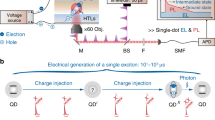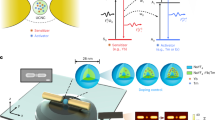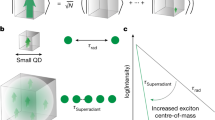Abstract
Nanocrystal quantum dots have favourable light-emitting properties. They show photoluminescence with high quantum yields, and their emission colours depend on the nanocrystal size—owing to the quantum-confinement effect—and are therefore tunable. However, nanocrystals are difficult to use in optical amplification and lasing. Because of an almost exact balance between absorption and stimulated emission in nanoparticles excited with single electron–hole pairs (excitons), optical gain can only occur in nanocrystals that contain at least two excitons. A complication associated with this multiexcitonic nature of light amplification is fast optical-gain decay induced by non-radiative Auger recombination, a process in which one exciton recombines by transferring its energy to another. Here we demonstrate a practical approach for obtaining optical gain in the single-exciton regime that eliminates the problem of Auger decay. Specifically, we develop core/shell hetero-nanocrystals engineered in such a way as to spatially separate electrons and holes between the core and the shell (type-II heterostructures). The resulting imbalance between negative and positive charges produces a strong local electric field, which induces a giant (∼100 meV or greater) transient Stark shift of the absorption spectrum with respect to the luminescence line of singly excited nanocrystals. This effect breaks the exact balance between absorption and stimulated emission, and allows us to demonstrate optical amplification due to single excitons.
This is a preview of subscription content, access via your institution
Access options
Subscribe to this journal
Receive 51 print issues and online access
$199.00 per year
only $3.90 per issue
Buy this article
- Purchase on Springer Link
- Instant access to full article PDF
Prices may be subject to local taxes which are calculated during checkout





Similar content being viewed by others
References
Alivisatos, A. P. Semiconductor clusters, nanocrystals, and quantum dots. Science 271, 933–937 (1996)
Klimov, V. I. (ed.) Semiconductor and Metal Nanocrystals: Synthesis and Electronic and Optical Properties (Marcel Dekker, New York, 2003)
Murray, C. B., Norris, D. J. & Bawendi, M. G. Synthesis and characterization of nearly monodisperse CdE (E = S, Se, Te) semiconductor nanocrystallites. J. Am. Chem. Soc. 115, 8706–8715 (1993)
Eisler, H.-J. et al. Color-selective semiconductor nanocrystal laser. Appl. Phys. Lett. 80, 4614–4616 (2002)
Malko, A. V. et al. From amplified spontaneous emission to microring lasing using nanocrystal quantum dot solids. Appl. Phys. Lett. 81, 1303–1305 (2002)
Klimov, V. I. et al. Optical gain and stimulated emission in nanocrystal quantum dots. Science 290, 314–317 (2000)
Klimov, V. I., Mikhailovsky, A. A., McBranch, D. W., Leatherdale, C. A. & Bawendi, M. G. Quantization of multiparticle Auger rates in semiconductor quantum dots. Science 287, 1011–1013 (2000)
Kazes, M., Lewis, D. Y., Evenstein, Y., Mokari, T. & Banin, U. Lasing from semiconductor quantum rods in a cylindrical microcavity. Adv. Mater. 14, 317–321 (2002)
Htoon, H., Hollingsworth, J. A., Dickerson, R. & Klimov, V. I. Zero- to one-dimensional transition and Auger recombination in semiconductor quantum rods. Phys. Rev. Lett. 91, 227401 (2003)
Ivanov, S. A. et al. Light amplification using inverted core/shell nanocrystals: Towards lasing in the single-exciton regime. J. Phys. Chem. B 108, 10625–10630 (2004)
Nanda, J. et al. Absorption cross sections and Auger recombination lifetimes in inverted core/shell nanocrystals: Implications for lasing performance. J. Appl. Phys. 99, 034309 (2006)
Norris, D. J., Sacra, A., Murray, C. B. & Bawendi, M. G. Measurement of the size-dependent hole spectrum in CdSe quantum dots. Phys. Rev. Lett. 72, 2612–2615 (1994)
Klimov, V. I. Optical nonlinearities and ultrafast carrier dynamics in semiconductor nanocrystals. J. Phys. Chem. B 104, 6112–6123 (2000)
Kang, K. I. et al. Confinement-enhanced biexciton binding energy in semiconductor quantum dots. Phys. Rev. B 48, 15449–15452 (1993)
Achermann, M., Hollingsworth, J. A. & Klimov, V. I. Multiexcitons confined within a subexcitonic volume: Spectroscopic and dynamical signatures of neutral and charged biexcitons in ultrasmall semiconductor nanocrystals. Phys Rev. B 68, 245302 (2003)
Piryatinski, A., Ivanov, S. A., Tretiak, S. & Klimov, V. I. Effect of quantum and dielectric confinement on the exciton-exciton interaction energy in type-II core/shell semiconductor nanocrystals. Nano Lett. 7, 108–115 (2007)
Cao, Y. C. & Wang, J. H. One-pot synthesis of high-quality zinc-blende CdS nanocrystals. J. Am. Chem. Soc. 126, 14336–14337 (2004)
Efros, A. L. & Rodina, A. V. Confined excitons, trions, and biexcitons in semiconductor microcrystals. Solid State Commun. 72, 645–649 (1989)
Schaller, R. D., Petruska, M. A. & Klimov, V. I. Tunable near-infrared optical gain and amplified spontaneous emission using PbSe nanocrystals. J. Phys. Chem. B 107, 13765–13768 (2003)
Shaklee, K. L., Nahory, R. E. & Leheny, R. F. Optical gain in semiconductors. J. Lumin. 7, 284–309 (1973)
Klimov, V. I. & McBranch, D. W. Femtosecond high-sensitivity, chirp-free transient absorption spectroscopy using kilohertz lasers. Opt. Lett. 23, 277–279 (1998)
Mikhailovsky, A. A., Malko, A. V., Hollingsworth, J. A., Bawendi, M. G. & Klimov, V. I. Multiparticle interactions and stimulated emission in chemically synthesized quantum dots. Appl. Phys. Lett. 80, 2380–2382 (2002)
Acknowledgements
This work was supported by the Chemical Sciences, Biosciences and Geosciences Division of the Office of Basic Energy Sciences, US Department of Energy (DOE), Los Alamos LDRD funds, and the Center for Integrated Nanotechnologies jointly operated for DOE by Los Alamos and Sandia National Laboratories.
Author information
Authors and Affiliations
Corresponding author
Ethics declarations
Competing interests
Reprints and permissions information is available at www.nature.com/reprints. The authors declare no competing financial interests.
Supplementary information
Supplementary Notes
This file contains extensive Supplementary Notes with additional references. (PDF 1179 kb)
Rights and permissions
About this article
Cite this article
Klimov, V., Ivanov, S., Nanda, J. et al. Single-exciton optical gain in semiconductor nanocrystals. Nature 447, 441–446 (2007). https://doi.org/10.1038/nature05839
Received:
Accepted:
Issue Date:
DOI: https://doi.org/10.1038/nature05839
This article is cited by
-
Heteroepitaxial chemistry of zinc chalcogenides on InP nanocrystals for defect-free interfaces with atomic uniformity
Nature Communications (2023)
-
InP colloidal quantum dots for visible and near-infrared photonics
Nature Reviews Materials (2023)
-
Optical gain and lasing from bulk cadmium sulfide nanocrystals through bandgap renormalization
Nature Nanotechnology (2023)
-
Localization and interaction of interlayer excitons in MoSe2/WSe2 heterobilayers
Nature Communications (2023)
-
Universal scaling laws for charge-carrier interactions with quantum confinement in lead-halide perovskites
Nature Communications (2023)
Comments
By submitting a comment you agree to abide by our Terms and Community Guidelines. If you find something abusive or that does not comply with our terms or guidelines please flag it as inappropriate.



